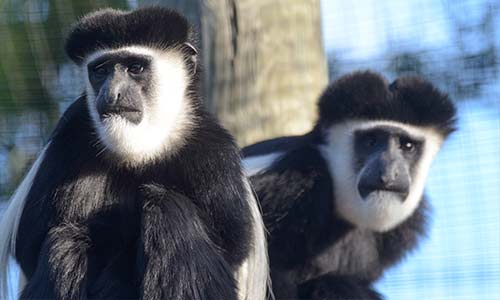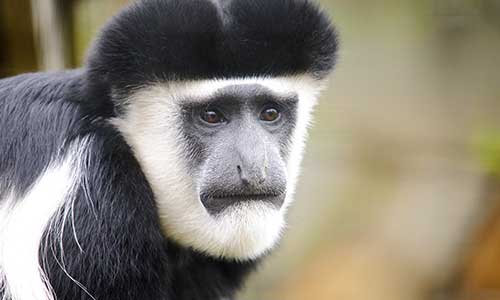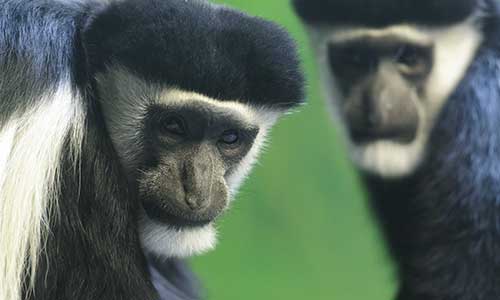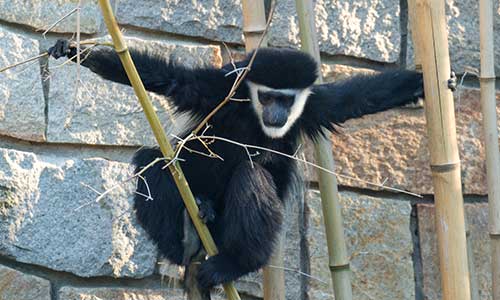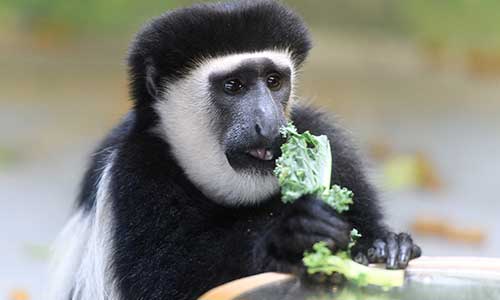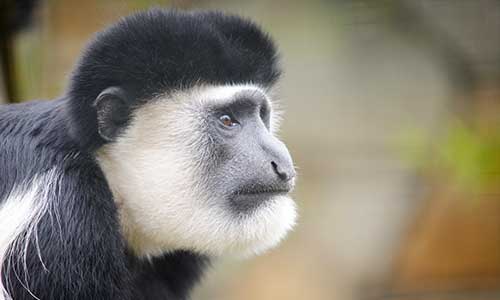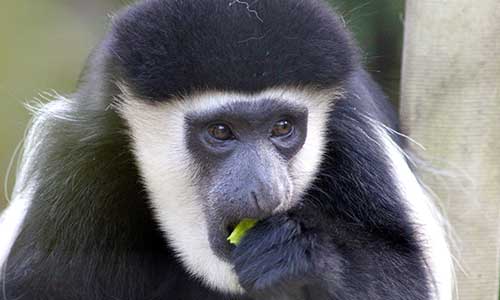Black and White Colobus Monkey
Colobus guereza
About the Black and White Colobus Monkey

Geographic Range:
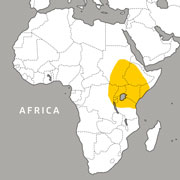
Class: Mammalia
Order: Primates
Family: Cercopithecidae
Genus: Colobus
Species: guereza
The colobus monkey’s long tail nearly equals the length of it body. Its mantle and tail act as “parachutes” as they make aerial leaps. This monkey’s name comes from the Greek word “kolobus” meaning, “mutilated one,” referring to their lack of thumbs. But this is actually an advantage, allowing them to swing easily through the trees.
Committed to Conservation
Zoo New England participates in the Guereza colobus Species Survival Plan. By sharing research and knowledge, participating institutions work together to establish guidelines that best ensure the health of captive populations, and with success, the survival of endangered species.
Colobus Monkey Facts
Appearance:
The colobus monkey’s body is covered with thick, black fur and a white mantle. The long, bushy, white tail nearly equals the length of its body. Their mantle and tail act as “parachutes” as they make aerial leaps. The face is bare and slate gray with a white brow and beard, camouflaging them in dense forests. The colobus monkey has only four digits on each hand. This monkey’s name comes from the Greek word “kolobus” meaning “mutilated one” and referring to their lack of thumbs. But this is actually an advantage, allowing them to swing more easily through the trees.
Size:
Body length: 20 to 26 inches
Tail length: 20 to 32 inches
Weight: 10 to 30 pounds
The male is larger than the female.
Diet:
In the wild: Colobus monkeys are herbivores, surviving primarily on leaves and buds. Their stomach is unique with several sacks, which helps in digesting a leafy diet and increasing extraction of nutrients—much in the same manner as other ruminants.
Reproduction:
There’s no defined breeding season, but births tend to coincide when food is available in greater abundance. Gestation is six months, generally leading to the birth of only a single offspring. Females reach sexual maturity at about age 4 and males between ages 4 and 6.
Behavior:
The colobus monkey is diurnal (active during the day) and spends most of its time in trees. It can leap 20 to 30 feet from one branch to another, but spends a good portion of its day resting. These monkeys travel in highly social troops of three to 15, usually led by a dominant male and consisting of several females with offspring of various ages. Females remain in their birth group for life while males leave in early adolescence, taking with them some females to form their own troops. Occasional bachelor groups and multi-male troops have also been documented.
They maintain their tight bonds through a wide variety of calls, displays and grooming rituals. Aggressive interactions are rare, but they’ll fiercely defend their 30 to 40 acre territories. A male will defend through chasing, physical displays, and vocalizations; physical attacks are rare.
Displays and vocalizations maintain group integrity. Shared care of infants also increases the group’s cohesiveness.
Habitat/Range:
The colobus monkey is strictly a forest dweller found from sea level to about 11,000 feet across equatorial Africa.
Life Expectancy:
Average 13 – 16 years
Predators:
Crowned hawk eagles, leopards, chimpanzees and humans.
Population Status:
Several populations and subspecies of colobus monkeys are endangered, but the species as a whole is not. These monkeys are hunted for their prized fur, and their habitat is dwindling.
Fun Fact:
This monkey's vocalizations and sounds can be roughly assigned to six basic categories: roaring, snorting, purring, cawing, squeaking, screaming and tongue-clicking.
You Can Find This Animal in the Treetops and Riverbeds
Fun Fact
The colobus is the most arboreal (prefers trees) than any other African monkey. They rarely descend to the ground and can be seen bouncing between branches.
You May Also Like
At Franklin Park Zoo:
At Stone Zoo:

